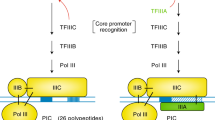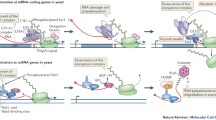Abstract
The human mitochondrial transcription termination factor (mTERF) is involved in the regulation of transcription of the mitochondrial genome. Similarity searches and phylogenetic analysis demonstrate that mTERF is a member of large and complex protein family (the MTERF family) shared amongst metazoans and plants. Interestingly, we identify three novel MTERF genes in vertebrates, which all encode proteins with predicted mitochondrial localization. Members of the MTERF family have so far not been detected in fungi, supporting the notion that mitochondrial transcription regulation may have evolved separately in yeast and animal cells.


Similar content being viewed by others
References
Altschul SF et al (1997) Gapped BLAST and PSI-BLAST: a new generation of protein database search programs. Nucleic Acids Res 25:3389–3402
Baldauf SL, Palmer JD (1993) Animals and fungi are each other’s closest relatives: congruent evidence from multiple proteins. Proc Natl Acad Sci USA 90:11558–11562
Baldauf SL, Roger AJ, Wenk-Siefert I, Doolittle WF (2000) A kingdom-level phylogeny of eukaryotes based on combined protein data. Science 290:972–977
Bateman A et al (2004) The Pfam protein families database. Nucleic Acids Res 32:D138–D141
Binder S, Brennicke A (2003) Gene expression in plant mitochondria: transcriptional and post-transcriptional control (discussion 188–189). Philos Trans R Soc Lond B Biol Sci 358:181–188
Daga A, Micol V, Hess D, Aebersold R, Attardi G (1993) Molecular characterization of the transcription termination factor from human mitochondria. J Biol Chem 268:8123–8130
Dairaghi DJ, Shadel GS, Clayton DA (1995) Addition of a 29 residue carboxyl-terminal tail converts a simple HMG box-containing protein into a transcriptional activator. J Mol Biol 249:11–28
Emanuelsson O, Nielsen H, Brunak S, von Heijne G (2000) Predicting subcellular localization of proteins based on their N-terminal amino acid sequence. J Mol Biol 300:1005–1016
Fernandez-Silva P et al (2001) Sea urchin mtDBP is a two-faced transcription termination factor with a biased polarity depending on the RNA polymerase. Nucleic Acids Res 29:4736–4743
Fisher RP, Clayton DA (1988) Purification and characterization of human mitochondrial transcription factor 1. Mol Cell Biol 8:3496–3509
Gaspari M, Larsson NG, Gustafsson CM (2004) The transcription machinery in mammalian mitochondria. Biochim Biophys Acta 1659:148–152
Gelfand R, Attardi G (1981) Synthesis and turnover of mitochondrial ribonucleic acid in HeLa cells: the mature ribosomal and messenger ribonucleic acid species are metabolically unstable. Mol Cell Biol 1:497–511
Higgins DG, Thompson JD, Gibson TJ (1996) Using CLUSTAL for multiple sequence alignments. Methods Enzymol 266:383–402
Kruse B, Narasimhan N, Attardi G (1989) Termination of transcription in human mitochondria: identification and purification of a DNA binding protein factor that promotes termination. Cell 58:391–397
Larsson NG et al (1998) Mitochondrial transcription factor A is necessary for mtDNA maintenance and embryogenesis in mice. Nat Genet 18:231–236
Loguercio Polosa P, Roberti M, Musicco C, Gadaleta MN, Quagliariello E, Cantatore P (1999) Cloning and characterisation of mtDBP, a DNA-binding protein which binds two distinct regions of sea urchin mitochondrial DNA. Nucleic Acids Res 27:1890–1899
Masters BS, Stohl LL, Clayton DA (1987) Yeast mitochondrial RNA polymerase is homologous to those encoded by bacteriophages T3 and T7. Cell 51:89–99
Montoya J, Christianson T, Levens D, Rabinowitz M, Attardi G (1982) Identification of initiation sites for heavy-strand and light-strand transcription in human mitochondrial DNA. Proc Natl Acad Sci USA 79:7195–7199
Page RD (1996) TreeView: an application to display phylogenetic trees on personal computers. Comput Appl Biosci 12:357–358
Parisi MA, Clayton DA (1991) Similarity of human mitochondrial transcription factor 1 to high mobility group proteins. Science 252:965–969
Parisi MA, Xu B, Clayton DA (1993) A human mitochondrial transcriptional activator can functionally replace a yeast mitochondrial HMG-box protein both in vivo and in vitro. Mol Cell Biol 13:1951–1961
Roberti M, Polosa PL, Bruni F, Musicco C, Gadaleta MN, Cantatore P (2003) DmTTF, a novel mitochondrial transcription termination factor that recognises two sequences of Drosophila melanogaster mitochondrial DNA. Nucleic Acids Res 31:1597–1604
Schinkel AH, Koerkamp MJ, Touw EP, Tabak HF (1987) Specificity factor of yeast mitochondrial RNA polymerase. Purification and interaction with core RNA polymerase. J Biol Chem 262:12785–12791
Schonfeld C, Wobbe L, Borgstadt R, Kienast A, Nixon PJ, Kruse O (2004) The nucleus-encoded protein MOC1 is essential for mitochondrial light acclimation in Chlamydomonas reinhardtii. J Biol Chem 279:50366–50374
Shang J, Clayton DA (1994) Human mitochondrial transcription termination exhibits RNA polymerase independence and biased bipolarity in vitro. J Biol Chem 269:29112–29120
Thompson JD, Higgins DG, Gibson TJ (1994) CLUSTAL W: improving the sensitivity of progressive multiple sequence alignment through sequence weighting, position-specific gap penalties and weight matrix choice. Nucleic Acids Res 22:4673–4680
Acknowledgements
This work was supported by grants from the Swedish Research Council (to MF, N-GL and CMG), the Swedish Cancer Society (to CMG), the Swedish Foundation for Strategic Research (to N-GL and CMG), the Swedish National Board for Laboratory Animals (to MF and CMG) and the Emil and Wera Cornell’s foundation (to MF).
Author information
Authors and Affiliations
Corresponding author
Additional information
Communicated by C. Köhler
Rights and permissions
About this article
Cite this article
Linder, T., Park, C.B., Asin-Cayuela, J. et al. A family of putative transcription termination factors shared amongst metazoans and plants. Curr Genet 48, 265–269 (2005). https://doi.org/10.1007/s00294-005-0022-5
Received:
Accepted:
Published:
Issue Date:
DOI: https://doi.org/10.1007/s00294-005-0022-5




